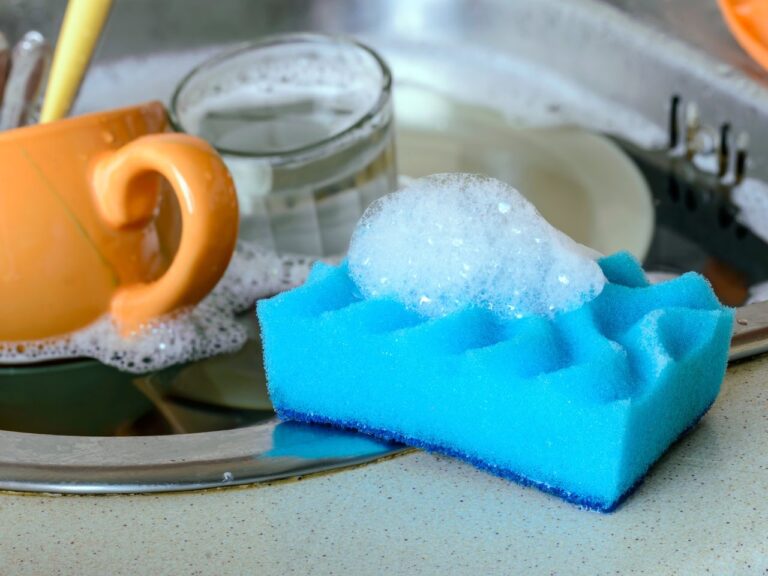Let’s talk about something gross that we’ve all encountered in the kitchen: a stinky sponge.
You know the one – it smells like a mix of old food and mildew, and you’re not quite sure if it’s doing more harm than good. Well, I hate to break it to you, but that smelly sponge is actually a breeding ground for bacteria.
In this post, we’re going to dive into the science of sponge bacteria, the health risks of dirty sponges, just how sick you can get from a dirty dish sponge, and answer the question – Why does my dish sponge smell?
The Science Behind Bacteria on Dish Sponges
Bacteria are tiny microorganisms that can cause illness and disease in humans. And unfortunately, your kitchen sponge is a prime location for bacteria to grow and multiply. In fact, studies have shown that dish sponges can harbor up to 10 million bacteria per square inch.
So, yikes! Bacteria is why your dish sponge smells.
Some of the most common types of bacteria found on sponges include E. coli, Salmonella, and Staphylococcus aureus. Exposure to these bacteria can cause symptoms ranging from stomach upset to severe infections.
Just How Sick Can You Get from a Dirty Dish Sponge?
You might be wondering just how sick you can get from using a dirty dish sponge. The answer is: pretty sick. If you’re exposed to harmful bacteria on a dirty sponge, you can experience symptoms like stomach cramps, diarrhea, and vomiting.
In more severe cases, you could develop a serious infection that requires medical treatment. And if you have a weakened immune system, you’re at an even greater risk of getting sick from dirty sponges. So, it’s definitely not worth taking the risk!
How to Keep a Dish Sponge From Smelling
So, what can you do to keep your sponge from developing that funky smell? The key is to keep your sponge clean and dry. After each use, rinse the sponge thoroughly with hot water and wring it out as much as possible.
You can also try hanging the sponge in a well-ventilated area to help it dry out faster. And if you’re really serious about keeping your sponge clean, consider using a sponge holder with drainage holes to allow air to circulate around the sponge.
When Should You Throw Out a Dish Sponge
No matter how well you take care of your sponge, there will come a time when you need to throw it out. According to experts, you should replace your sponge at least once every two weeks.
And if your sponge starts to develop a bad odor or show signs of wear and tear, it’s time to toss it out and replace it with a fresh one. Remember, a clean sponge is a healthy sponge!
How Quickly Does a Dish Sponge Breed Bacteria
You might be wondering just how quickly those bacteria are multiplying on your sponge. According to a study by the National Sanitation Foundation, it only takes a few hours for bacteria to start growing on a damp sponge.
And within a day, that sponge can harbor millions of bacteria. That’s why it’s so important to clean and sanitize your sponge regularly to keep those bacteria at bay.
Should We Even Be Using Dish Sponges at All?
While it’s true that dish sponges can harbor harmful bacteria, it’s not necessarily the case that we should stop using them altogether. According to experts, dish sponges are still an effective way to clean dishes and surfaces, as long as they are properly maintained and replaced regularly. In fact, many kitchen experts recommend using a sponge in combination with a cleaning solution to get dishes truly clean.
However, if you’re concerned about the bacteria on your sponge, there are alternatives you can consider. For example, you could switch to using a dish brush or a washcloth instead of a sponge.
Or, you could consider using disposable cleaning wipes or paper towels for some cleaning tasks. Ultimately, the decision of whether or not to use a dish sponge is up to you, but there are certainly ways to minimize the risks associated with using one.
Conclusion
So there you have it, – the gross (but important) truth about dirty sponges. By taking a few simple steps to keep your sponge clean and dry, and replacing it regularly, you can protect yourself and your family from harmful bacteria.
Remember to clean and sanitize your sponge regularly, and don’t be afraid to toss it out if it starts to develop a bad odor. With these tips, you can keep your kitchen smelling fresh and your family healthy.
FAQ
Q: How often should I replace my dish sponge?
A: Experts recommend replacing your dish sponge every two to four weeks. If your sponge develops an odor or shows signs of mold, it’s best to replace it immediately.
Q: How do I clean my dish sponge?
A: You can clean your dish sponge by soaking it in a mixture of hot water and vinegar or by running it through the dishwasher. Be sure to wring out the sponge and let it air dry completely before using it again.
Q: Can I get sick from using a dirty dish sponge?
A: Yes, dish sponges can harbor harmful bacteria such as E. coli, salmonella, and staphylococcus. These bacteria can potentially cause illness if they come into contact with food or surfaces that are later consumed.
Q: What are the signs that my dish sponge is growing mold?
A: Mold can appear as black or green spots on the surface of the sponge. If you see mold on your sponge, it’s best to throw it out immediately.
Q: Are there any alternatives to using a dish sponge?
A: Yes, you can consider using a dish brush or a washcloth instead of a sponge. You can also use disposable cleaning wipes or paper towels for some cleaning tasks.
Better Living uses affiliate links. If you make a purchase through them, we may receive a small commission (for which we are deeply grateful) at no cost to you.



